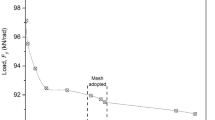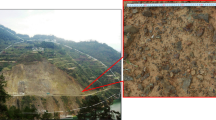Abstract
Root pile is a new type of pile that improves the load carrying capacity by roots penetrating into soils. To carry out the nonlinear settlement analysis of such a root pile in multilayered soils, the hyperbolicity-based load transfer model is in this paper reformulated to account for the discontinuities between the segments with and without roots. The procedure to determine the model parameters for root piles is presented accordingly. The feasibility and reliability of such a proposed modified hyperbolic model for nonlinear settlement analysis of root piles in multilayered soils are verified by a numerical case and two real experimental cases. The numerical case study shows that the root pile does increase the pile load carrying capacity to some extent. In a parametric study based on this numerical case, it can be found that the bearing capacity of root piles increases along with the increase in the root number, size, depth and the elastic modulus of the surrounding soil. The loading test results on two real root piles sited in Chizhou Yangtze River Bridge, China, are used to further verify the proposed method. Comparing with other analytical methods, it is demonstrated that the proposed method incorporated with the proposed modified hyperbolic model can achieve a better agreement with the measured ones especially in a large loading stage.
















Similar content being viewed by others
References
Ai ZY, Han J (2009) Boundary element analysis of axially loaded piles embedded in a multi-layered soil. Comput Geotech 36(3):427–434. https://doi.org/10.1016/j.compgeo.2008.06.001
Baguelin F, Frank R (1980) Theoretical studies of piles using the finite element method. Inst Civ Eng (ICE) Num Methods Offshore Piling London, UK 11:83–91
Butterfield R, Banerjee PK (1971) The Elastic Analysis of Compressible Piles and Pile Groups. Géotechnique 21(1):43–60. https://doi.org/10.1680/geot.1971.21.1.43
Carrubba P (1997) Skin friction on large-diameter piles socketed into rock. Can Geotech J 34(2):230–240. https://doi.org/10.1139/t96-104
Clough GM, Duncan JM (1971) Finite element analyses of retaining wall behavior. J Soil Mech Found Div, ASCE 97(12):1657–1673
Comodromos EM, Papadopoulou MC, Rentzeperis IK (2009) Pile foundation analysis and design using experimental data and 3-D numerical analysis. Comput Geotech 36(5):819–836. https://doi.org/10.1016/j.compgeo.2009.01.011
Ergun MU, Akbulut H (1995) Bearing capacity of shaft-expanded driven model piles in sand. Géotechnique 45(4):715–718. https://doi.org/10.1680/geot.1995.45.4.715
Guo WD, Randolph MF (1998) Rationality of load transfer approach for pile analysis. Comput Geotech 23(1):85–112. https://doi.org/10.1016/S0266-352X(98)00010-X
Ha HB, O’neill MW, (1983) Discussion of “Theoretical t-z Curves.” J Geotech Eng Div, ASCE 109(10):1353–1355. https://doi.org/10.1061/(ASCE)0733-9410(1983)109:10(1353)
Huang M, Jiang S, Xu C, Xu D (2020) A new theoretical settlement model for large step-tapered hollow piles based on disturbed state concept theory. Comput Geotech 124:103626. https://doi.org/10.1016/j.compgeo.2020.103626
Huang MS, Zhang CR, Mu LL, Gong W (2011) Analysis of anchor foundation with root caissons loaded in nonhomogeneous soils. Can Geotech J 48(2):234–246. https://doi.org/10.1139/T10-046
Janbu N (1976) Static bearing capacity of friction piles. In: Proceedings of the 6th European conference on SMFE, March, Vienna, Austria, 23(1.2): 479–488.
Kraft LM, Ray RP, Kagawa T (1981) Theoretical t-z curves. J Geotech Eng Div ASCE 107(11):1543–1561
Lee KM, Xiao ZR (2001) A simplified nonlinear approach for pile group settlement analysis in multilayered soils. Can Geotech J 38(5):1063–1080. https://doi.org/10.1139/cgj-38-5-1063
Liu JY, Gao HM, Liu HL (2012) Finite element analyses of negative skin friction on a single pile. Acta Geotech 7(3):239–252. https://doi.org/10.1007/s11440-012-0163-x
Lv YR, Liu HL, Ng CWW, Gunawan A, Ding XM (2014) A modified analytical solution of soil stress distribution for XCC pile foundations. Acta Geotech 9(3):529–546. https://doi.org/10.1007/s11440-013-0280-1
Manandhar S, Yasufuku N (2013) Vertical bearing capacity of tapered piles in sands using cavity expansion theory. Soils Found 53(6):853–867. https://doi.org/10.1016/j.sandf.2013.10.005
Poulos HG, Davis EH (1980) Pile foundation analysis and design. Wiley, New York
Randolph MF, Carter JP, Wroth CP (1979) Driven piles in clay—the effects of installation and subsequent consolidation. Géotechnique 29(4):361–393. https://doi.org/10.1680/geot.1979.29.4.361
Randolph MF, Wroth CP (1978) Analysis of deformation of vertically loaded piles. J Geotech Eng Div ASCE 104(12):1465–1488. https://doi.org/10.1016/0148-9062(79)90663-6
Seed HB, Reese LC (1955) The action of soft clay along friction piles. Trans ASCE 122:731–754
Sheng DC, Eigenbrod KD, Wriggers P (2005) Finite element analysis of pile installation using large-slip frictional contact. Comput Geotech 32(1):17–26. https://doi.org/10.1016/j.compgeo.2004.10.004
Singh S, Patra NR (2020) Axial behavior of tapered piles using cavity expansion theory. Acta Geotech 15(6):1619–1636. https://doi.org/10.1007/s11440-019-00866-y
Suits LD, Sheahan TC, Dai GL, Gong WM, Zhao XL, Zhou XQ (2011) Static Testing of Pile-Base Post-Grouting Piles of the Suramadu Bridge. Geotech Test J 34:102926. https://doi.org/10.1520/GTJ102926
Wei JQ, El Naggar MH (1998) Experimental study of axial behaviour of tapered piles. Can Geotech J 35(4):641–654. https://doi.org/10.1139/t98-033
Wu P, Gong WM, Liang ST (2007) Study on load transfer law of overlength piles considering depth effect. Chin J Rock Soil Mechan 06:202–205 (in Chinese)
Xiao HB, Luo QZ, Tang J, Li QS (2002) Prediction of load–settlement relationship for large-diameter piles. Struct Des Tall Build 11(4):285–293. https://doi.org/10.1002/tal.201
Zhang MX, Xu P, Cui WJ, Gao YB (2018) Bearing behavior and failure mechanism of squeezed branch piles. J Rock Mechan Geotech Eng 10(5):935–946. https://doi.org/10.1016/j.jrmge.2017.12.010
Zhang QQ, Zhang ZM, He JY (2010) A simplified approach for settlement analysis of single pile and pile groups considering interaction between identical piles in multilayered soils. Comput Geotech 37(7–8):969–976. https://doi.org/10.1016/j.compgeo.2010.08.003
Zhou JJ, Gong XN, Wang KH, Zhang RH, Yan TL (2016) A Model Test on the Behavior of a Static Drill Rooted Nodular Pile Under Compression. Mar Georesour Geotechnol 34(3):293–301. https://doi.org/10.1080/1064119X.2015.1012313
Zhou H, Liu HL, Ding XM, Kong GQ (2020) A p–y curve model for laterally loaded XCC pile in soft clay. Acta Geotech 15(11):3229–3242. https://doi.org/10.1007/s11440-020-00944-6
Acknowledgements
Financial supports from Shenzhen Science and Technology program under Grant No. KQTD20180412181337494 and National Natural Science Foundation of China under Grant No. 51778204 are acknowledged.
Author information
Authors and Affiliations
Contributions
X-GL contributed to conceptualization, methodology, data curation, and writing—original draft. W-XR contributed to investigation, supervision, validation, and writing—review and editing. Y-GY contributed to investigation and experimenting. Y-CY provided the software and performed data curation.
Corresponding author
Ethics declarations
Conflict of interest
The authors declare that they have no conflict of interest.
Additional information
Publisher's Note
Springer Nature remains neutral with regard to jurisdictional claims in published maps and institutional affiliations.
Rights and permissions
About this article
Cite this article
Luo, XG., Ren, WX., Yin, YG. et al. A modified hyperbolicity-based load transfer model for nonlinear settlement analysis of root piles in multilayered soils. Acta Geotech. 17, 303–317 (2022). https://doi.org/10.1007/s11440-021-01215-8
Received:
Accepted:
Published:
Issue Date:
DOI: https://doi.org/10.1007/s11440-021-01215-8




